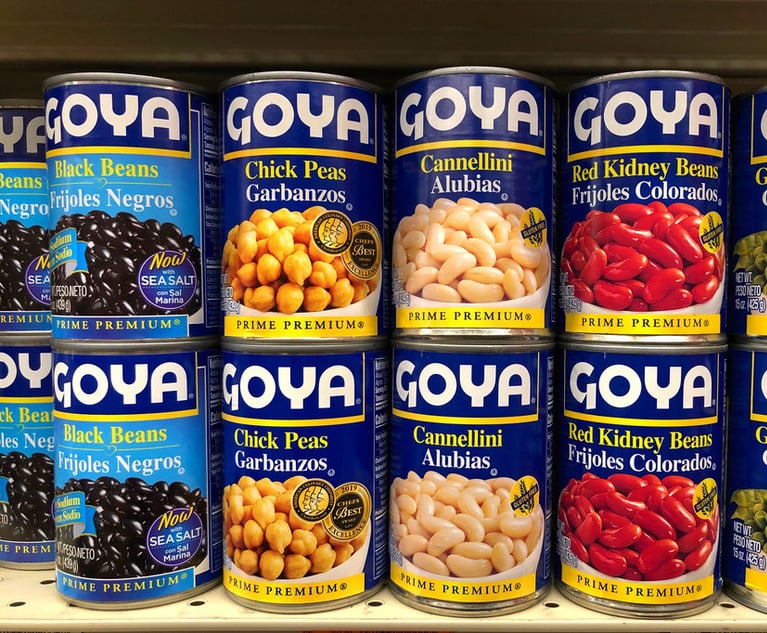America Invents Act provides patent marking relief
Patent owners that practice their invention are at a disadvantage compared to nonproducing patentees.
December 11, 2012 at 06:10 AM
3 minute read
The original version of this story was published on Law.com
Patent owners that practice their invention are at a disadvantage compared to nonproducing patentees. The patent marking statute, 35 U.S.C. § 287(a), says that patentees that make and sell patented products or authorize others to do so, may mark their patented products and put the public on notice that the product is patented. However, failure to mark a patented product made or offered for sale limits the infringement damages available to the patent owner. In the absence of patent marking, damages are recoverable only for infringement that occurs after the infringer received notice of the infringement. Thus, for patent owners that make and sell a patented product without marking it, the patent marking statute operates as a forfeiture of damages, which may be substantial depending on the duration of infringement prior to providing the infringer with notice. There is no corresponding risk of forfeiture for nonproducing patentees.
From a practical standpoint, one of the challenges many patent owners face is the manufacturing cost of changing tooling and dies when a patent issues for a product that it may have been making and selling for years. This challenge is further complicated by the fact that a product, or components or subsystems of the product, may be covered by multiple patents, each with a different expiration date. From a legal standpoint, it may not be possible to know which patent or patents are likely to be most important from an enforcement perspective and which are most critical to be included in the patent marking strategy.
The recently enacted American Invents Act (AIA) provides some relief. Patent owners are no longer required to include the patent number on the product or packaging. They can now simply include the word “patent” or “patented” or the abbreviation “pat” together with an address of a posting on the Internet that associates the patented article with the patent number. The site must be accessible to the public free of charge. As a result, patent owners can now update a web site with their products' patent information rather than changing their manufacturing equipment each time a patent issues or expires.
The AIA also reduces the risk of exposure to false patent marking lawsuits. Prior to the amendment to 35 U.S.C. § 292 under the AIA, plaintiffs could file qui tam actions, purportedly on behalf of the public, and seek to collect statutory damages (shared with the government) of up to $500 per unit sold of products that were marked with expired patents. In view of the manufacturing challenges of updating patent information for a product, there was no shortage of products in the marketplace marked with expired patent numbers. False marking suits became a favorite among plaintiffs. The AIA amended the false marking statute to permit only the U.S. government to collect statutory damages for false marking, and to limit the damages private plaintiffs can collect to actual damages from competitive injuries caused by the alleged false patent marking.
The AIA provides relief to patent owners by reducing exposure to frivolous false patent marking lawsuits, and by providing for virtual patent marking. Patent owners that make and sell patented products, or authorize others to do so, should consider implementing a virtual patent marking regime to avoid the risk of forfeiting infringement damages and devaluing their patents.
This content has been archived. It is available through our partners, LexisNexis® and Bloomberg Law.
To view this content, please continue to their sites.
Not a Lexis Subscriber?
Subscribe Now
Not a Bloomberg Law Subscriber?
Subscribe Now
NOT FOR REPRINT
© 2025 ALM Global, LLC, All Rights Reserved. Request academic re-use from www.copyright.com. All other uses, submit a request to [email protected]. For more information visit Asset & Logo Licensing.
You Might Like
View All
Best Practices for Adopting and Adapting to AI: Mitigating Risk in Light of Increasing Regulatory and Shareholder Scrutiny
7 minute read
FOMO Run Amok? Resolve of Firms Chasing AI Dreams Tested by Sky-High Costs


Trending Stories
Who Got The Work
Michael G. Bongiorno, Andrew Scott Dulberg and Elizabeth E. Driscoll from Wilmer Cutler Pickering Hale and Dorr have stepped in to represent Symbotic Inc., an A.I.-enabled technology platform that focuses on increasing supply chain efficiency, and other defendants in a pending shareholder derivative lawsuit. The case, filed Oct. 2 in Massachusetts District Court by the Brown Law Firm on behalf of Stephen Austen, accuses certain officers and directors of misleading investors in regard to Symbotic's potential for margin growth by failing to disclose that the company was not equipped to timely deploy its systems or manage expenses through project delays. The case, assigned to U.S. District Judge Nathaniel M. Gorton, is 1:24-cv-12522, Austen v. Cohen et al.
Who Got The Work
Edmund Polubinski and Marie Killmond of Davis Polk & Wardwell have entered appearances for data platform software development company MongoDB and other defendants in a pending shareholder derivative lawsuit. The action, filed Oct. 7 in New York Southern District Court by the Brown Law Firm, accuses the company's directors and/or officers of falsely expressing confidence in the company’s restructuring of its sales incentive plan and downplaying the severity of decreases in its upfront commitments. The case is 1:24-cv-07594, Roy v. Ittycheria et al.
Who Got The Work
Amy O. Bruchs and Kurt F. Ellison of Michael Best & Friedrich have entered appearances for Epic Systems Corp. in a pending employment discrimination lawsuit. The suit was filed Sept. 7 in Wisconsin Western District Court by Levine Eisberner LLC and Siri & Glimstad on behalf of a project manager who claims that he was wrongfully terminated after applying for a religious exemption to the defendant's COVID-19 vaccine mandate. The case, assigned to U.S. Magistrate Judge Anita Marie Boor, is 3:24-cv-00630, Secker, Nathan v. Epic Systems Corporation.
Who Got The Work
David X. Sullivan, Thomas J. Finn and Gregory A. Hall from McCarter & English have entered appearances for Sunrun Installation Services in a pending civil rights lawsuit. The complaint was filed Sept. 4 in Connecticut District Court by attorney Robert M. Berke on behalf of former employee George Edward Steins, who was arrested and charged with employing an unregistered home improvement salesperson. The complaint alleges that had Sunrun informed the Connecticut Department of Consumer Protection that the plaintiff's employment had ended in 2017 and that he no longer held Sunrun's home improvement contractor license, he would not have been hit with charges, which were dismissed in May 2024. The case, assigned to U.S. District Judge Jeffrey A. Meyer, is 3:24-cv-01423, Steins v. Sunrun, Inc. et al.
Who Got The Work
Greenberg Traurig shareholder Joshua L. Raskin has entered an appearance for boohoo.com UK Ltd. in a pending patent infringement lawsuit. The suit, filed Sept. 3 in Texas Eastern District Court by Rozier Hardt McDonough on behalf of Alto Dynamics, asserts five patents related to an online shopping platform. The case, assigned to U.S. District Judge Rodney Gilstrap, is 2:24-cv-00719, Alto Dynamics, LLC v. boohoo.com UK Limited.
Featured Firms
Law Offices of Gary Martin Hays & Associates, P.C.
(470) 294-1674
Law Offices of Mark E. Salomone
(857) 444-6468
Smith & Hassler
(713) 739-1250






